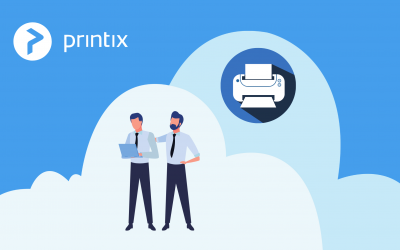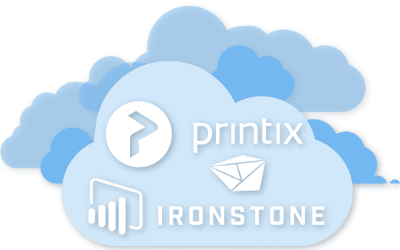When it comes to technology that enables sustainability, the innovation behind the cloud is making it possible to discover new ways to improve all aspects of our lives—now and in the future.
Printix is a cloud-based solution helping companies manage sustainability goals for their print environment. It’s a Software as a Service (SaaS) solution that can discover and connect to real-time data sources and enable intelligent insights, empowering organizations to make better decisions, faster.
Sustainability Advantages of Printix Cloud Print Service
The cloud has made it possible to access and share information from anywhere, anytime, without the need for physical storage and transportation of data. Printing technology has evolved to support this trend, with cloud technology revolutionizing and uplifting printing practices.
Printix has played an integral role in pioneering the development of cloud print services since 2014. Printix was founded on the vision of empowering businesses to move print infrastructure to the cloud with SaaS — an idea no other technology provider was investigating.
We believed businesses could improve their sustainability by lowering the need for on-premises energy consumption, minimizing waste, and securing their existing printer fleet.
And we were right.
Today, Printix continues to offer cutting-edge technology and expert support to help businesses of all sizes modernize their print environment and improve efficiency.
On this journey, we proved beyond doubt that:
- Removing hardware infrastructure and on-premises devices, such as print servers, reduces the cost and impact of energy consumption.
- Reducing the time and effort spent on software infrastructure and maintaining a print environment led to additional cost savings.
Supporting innovation with the right infrastructure
For the past decade, many companies have dedicated many people-hours to optimizing their hardware, neglecting the underlying infrastructure.
When businesses move to the cloud, they often review their work processes. One of the work path elements they try to eliminate is paper because of the efficiency improvements realized by working digitally. Thus, the market saturation of printers and paper is declining. According to IDC, there is an expected 4.8% decline year over year in the page volumes printed in the document print market. *

*Source: IDC Page Volume Program, Baseline Scenario Forecast, June 2020.
With the rise of cloud computing, businesses are reviewing their print environments and considering ways to optimize and future-proof. At Printix, we can help implement the right infrastructure to support business goals and continuous improvement.
Printix assists with the transition away from on-premises hardware, retiring legacy print servers. (One of our customers in Norway moved to Printix and eliminated more than 70 on-prem print servers globally while optimizing their infrastructure on Azure and in the Printix Cloud.)
Businesses should consider what printers they may need in the future, rather than continuing to rely on big, high-energy-consuming devices like A3 multifunction printers. We empower businesses with insights into their print usage and behavior to help them make more sustainable and suitable printing decisions.
Printix helps businesses meet sustainability demands by optimizing print infrastructure, and reducing energy costs and emissions associated with on-premise hardware. We also ensure that existing printers are reused while providing insights into print usage, creating a modern and future-proof print environment.
In regard to sustainability, this Tree-O-Meter page in the Power BI report shows trees saved, due to printing in mono vs color and to-sided rather than one-sided.

See Printix Insights on Microsoft Power BI and view the Power BI Report.
How is Printix sustainable?
We modernize printing for office workers, at the same time improve sustainability by lowering the need for on-premises power and cooling consumption while and at the same time ensuring that the investment into existing printers can be reused.
As a print management solution, Printix offers several sustainability benefits, contributing to a more environmentally friendly approach to printing. Here are some key sustainability benefits of Printix:
1. Reduced Paper Consumption:
Printix helps optimize printing practices by implementing rules and guidelines to reduce unnecessary printing. By encouraging double-sided printing, and defaulting to black and white, organizations can significantly reduce paper consumption, leading to lower deforestation rates and less waste.
2. Waste Reduction:
Printix can help minimize waste generation by enabling digital workflows and promoting electronic document sharing and storage. By encouraging employees to adopt digital alternatives, organizations can reduce the need for printing, resulting in less paper waste and a smaller environmental footprint.
3. Efficient Printer Fleet Management:
Printix enables centralized management of printer fleets, including monitoring printer usage, identifying inefficient devices, and optimizing printer deployment. By consolidating and optimizing the printer fleet, organizations can eliminate redundant or underutilized devices, reducing resource consumption and waste.
4. Enhanced Print Tracking and Reporting:
Printix offers detailed tracking and reporting capabilities, providing insights into printing patterns, volumes, and costs. This information helps organizations identify areas of improvement, implement targeted conservation measures, and raise employee awareness about their printing habits, leading to more responsible and sustainable printing practices.
5. Remote Printing and Mobility:
Printix supports remote printing capabilities, allowing users to send print jobs from mobile devices or laptops to designated printers. This feature reduces the need for printing multiple copies or traveling to specific locations to collect printed documents, resulting in less paper waste and lower carbon emissions associated with transportation.
By adopting Printix’s cloud print management solution, organizations can significantly contribute to sustainability goals by reducing paper waste, conserving energy, optimizing printer fleets, promoting digital workflows, and fostering a culture of responsible printing. They can keep their investment in the existing print infrastructure and at the same time move to the cloud and get the benefit of modern printing.




